Holy See of Cilicia
The Armenian Catholicosate of the Great House of Cilicia (Armenian: Կաթողիկոսութիւն Հայոց Մեծի Տանն Կիլիկիոյ) is an autocephalous Oriental Orthodox church.[2] Since 1930, the Catholicosate of the Great House of Cilicia has been headquartered in Antelias, Lebanon. Aram I is the Catholicos of Cilicia since 1995.
| Catholicosate of the Great House of Cilicia Holy See of Cilicia | |
|---|---|
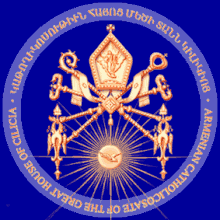 The coat of arms of the Catholicosate of the Great House of Cilicia | |
| Classification | Oriental Orthodox |
| Primate | Catholicos Aram I |
| Language | Western Armenian |
| Headquarters | Antelias, Lebanon Previously Sis, Turkey |
| Territory | Cilicia and Western Armenia |
| Possessions | Middle East, Europe, North America, South America, Oceania, and Africa. |
| Founder | The Apostles Bartholomew and Thaddeus |
| Independence | Apostolic Era |
| Recognition | by Armenian Apostolic Church as an autocephalous church |
| Members | 200,000[1] |
| Official website | Armenian Catholicosate of the Great House of Cilicia |
| Part of a series on |
| Oriental Orthodoxy |
|---|
 |
| Oriental Orthodox churches |
|
|
Great House of Cilicia eras
- First Sis era, 267-301: According to the order of Catholicoi, *St. Gregory I the Enlightener (also known as Gregory the Illuminator) was seated in Sis 267-301 before moving to Etchmiadzin in 301 where he continued in office until 325.
- In 485 AD, the Catholicosate was transferred to the new capital of Armenia Dvin. In the 10th century it moved from Dvin to Dzoravank and then to Aghtamar (927 AD), to Arghina (947 AD) and to Ani (992 AD)
- Sivas era, 1058–1062
- Tavbloor era, 1062–1066
- Dzamendav (Zamidia, now Zamantı) era, 1066–1116
- Dzovk (Present aka Island of Gölcük and under the lake of Hazar), era, 1116–1149
- Hromgla (now Halfeti) era, 1149–1293
- Second Sis era, 1293-1930 (with the Catholicosate of All Armenians returned to Etchmiadzin in 1441)
- Antelias, Lebanon era, since 1930 - having transferred there from Sis in Cilicia in the aftermath of the Armenian genocide.
Early history of the Armenian Church
The origin of the Armenian Church dates back to the Apostolic age and according to the ancient tradition was established by St. Thaddeus and St. Bartholomew. In 301 AD, Christianity was officially accepted by the Armenians as the state religion.[3]
Catholicosate in Sis (1293–1930)
The city of Sis (modern-day Kozan, Adana, Turkey) was the center of the Catholicosate of the Great House of Cilicia for more than six centuries, starting in 1293 when the Catholicosate moved from Hromgla to Sis. The monastery of St. Sophia of Sis, home of the Catholicosate, dominates the town in early 20th-century photographs. During the Armenian genocide, in 1915, the Armenian population in Cilicia was mostly destroyed.[4]
Two Catholicosates starting in 1441 AD
In 1441, a new Catholicos of All Armenians was elected in Holy Etchmiadzin in the person of Kirakos I Virapetsi of Armenia. At the same time the retiring Catholicos in Sis Gregory IX Mousabegian (1439–1446) remained as the Catholicos of the Great House of Cilicia. Therefore, since 1441, there have been two Catholicosates in the Armenian Apostolic Church. The Catholicos of All Armenians resides in the Mother See of Holy Etchmiadzin.
Catholicosate in Antelias, Lebanon (1930–present)
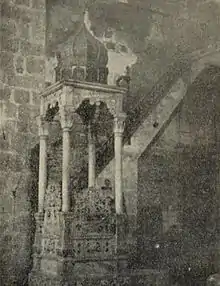
In 1922 the American Committee for Relief in the Near East established an orphanage in Antilias for survivors of the genocide. It continued operating until 1928. After the foundation's Executive Committee was petitioned in 1929 by Sahak II, in 1930 the now-vacant buildings of the orphanage were leased to the Cilicia Catholicosate for a period of five years to be used as a seat for the Catholicosate and a seminary for training priests and teachers. The foundation also agreed to contribute $6000-$7000 yearly towards running costs.[5]
Publications
Hask
The Catholicossate has its own publishing house and has a number of publications, most notably the monthly "Hask" (in Armenian Հասկ), the official organ of the Holy See of Cilicia.
Others
The Catholicosate also publishes a great number of books in Armenian and other languages, mainly on church literature as well as Armenian historical, cultural and literary subjects and series/collections of important Armenian literature.
The Catholicosate of the Great House of Cilicia also organizes an annual book fair on the occasion of Feast of the Holy Translators (known also as Surb Tarkmantchats), an official holiday on the calendar of the Armenian Apostolic Church to commemorate the legacy of the translators of the Bible and other Christian religious books to Armenian language in the 5th century.
Hask Armenological Review
It also publishes the annual "Hask Armenological Review" (in Armenian Հասկ Հայագիտական Հանդէս) on Armenian studies
Prelacies and Dioceses, and Churches
(in parentheses, the residence of the Prelate / Archbishop / Bishop)
- Canada
- United States of America
- Armenian Prelacy of the Eastern United States
- Armenian Prelacy of the Western United States
- Ontario
- Lebanon
- Syria
- Cyprus
- Armenian Diocese of Cyprus, in Nicosia
- Nicosia
- Sourp Asdvadzadzin church (1981).
- Old Sourp Asdvadzadzin church (1308), as of 1964 under Turkish occupation.
- Sourp Boghos chapel (1892).
- Sourp Haroutiun chapel (1938).
- Sourp Amenapergitch chapel (1995).
- Nicosia
- Famagusta
- Ganchvor church (1346), as of 1964 under Turkish occupation.
- Larnaca
- Sourp Stepanos church (1909).
- Limassol
- Sourp Kevork church (1939).
- Armenian Diocese of Cyprus, in Nicosia
Gallery
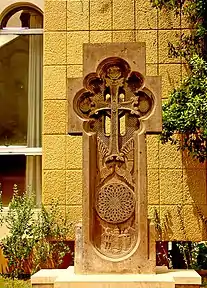 A khatchkar on the premises
A khatchkar on the premises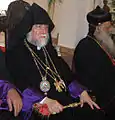
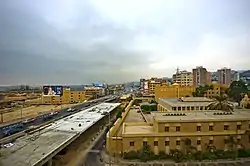 Partial view of the Catholicosate complex on the Mediterranean Sea in Antelias
Partial view of the Catholicosate complex on the Mediterranean Sea in Antelias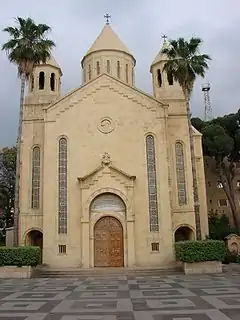 Saint Gregory the Illuminator Cathedral (1940)
Saint Gregory the Illuminator Cathedral (1940) Interior of the St. Gregory the Illuminator Cathedral
Interior of the St. Gregory the Illuminator Cathedral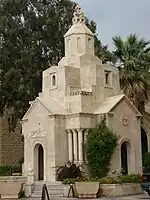 Memorial chapel to the Armenian genocide at the Catholicosate premises in Antelias
Memorial chapel to the Armenian genocide at the Catholicosate premises in Antelias
 Holy Mother of God Church (Sourp Asdvadzadzin) at the seminary in Bikfaya
Holy Mother of God Church (Sourp Asdvadzadzin) at the seminary in Bikfaya
See also
References
- Mekaelian, M. (2018, September 24). The Necessity of Preserving Western Armenian. The Armenian Weekly. https://armenianweekly.com/2018/09/24/the-necessity-of-preserving-western-armenian/
- "Frequently Asked Questions on the Cilician See of the Armenian Apostolic Church / Georgy S Thomas". Malankara Orthodox TV. 3 October 2017. Retrieved 2020-01-01.
- Herszenhorn, David M. (October 3, 2013). "Armenian Church, Survivor of the Ages, Faces Modern Hurdles" – via NYTimes.com.
- "Documents 119-129. Bryce. Armenians. XV---Cicilia (Vilayet of Adan and Sankjak of Marash)". net.lib.byu.edu.
- Anon, "The Armenian Catholicosate of Cilicia", Boston 1948.
Sources
- Stopka, Krzysztof (2016). Armenia Christiana: Armenian Religious Identity and the Churches of Constantinople and Rome (4th-15th century). Kraków: Jagiellonian University Press. ISBN 9788323395553.
